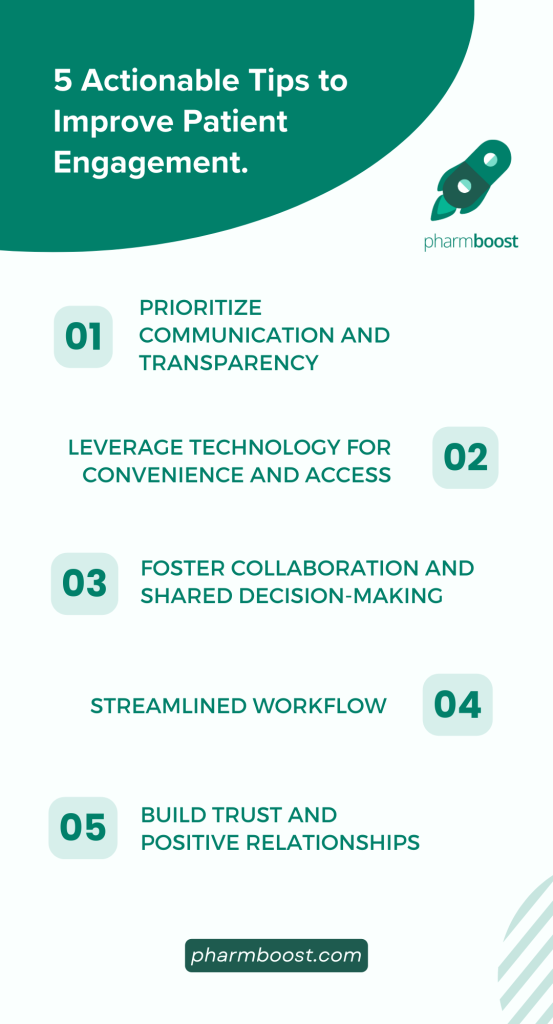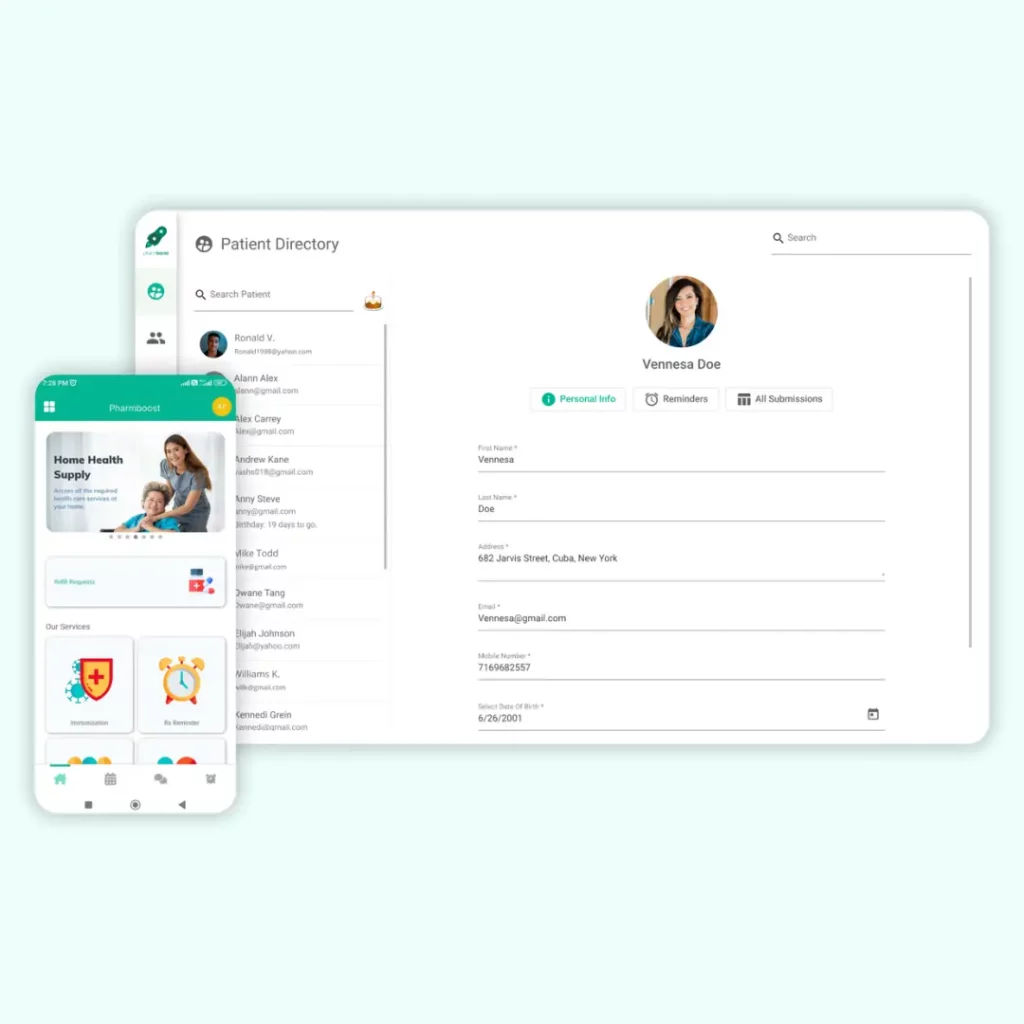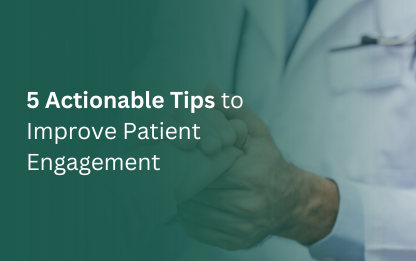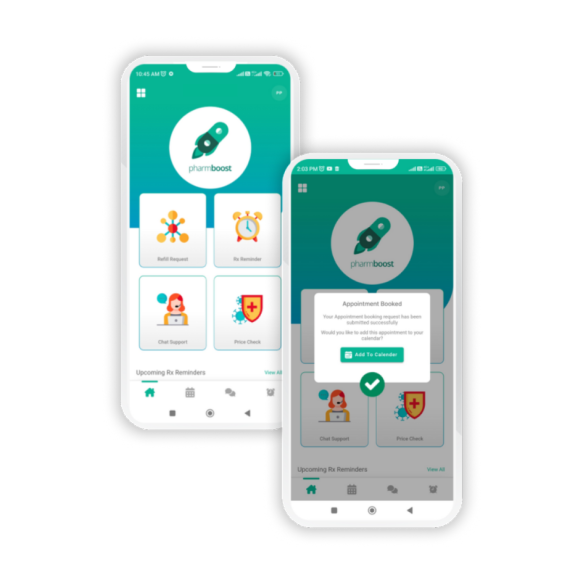May 22, 2024
Introduction
In today's healthcare landscape, patient engagement is a necessity. Engaged patients are more likely to adhere to treatment plans, experience better health outcomes, and cultivate stronger relationships with their healthcare providers. However, achieving true patient engagement can feel like a challenge.
This blog post offers 5 actionable tips that healthcare professionals and institutions can implement to improve patient engagement and foster a more collaborative, positive healthcare experience.
5 Actionable Tips to Improve Patient Engagement
Engaged patients are active participants in their healthcare journey. They are more likely to ask questions, follow treatment plans, and collaborate with their healthcare providers for better health outcomes. But how can you, as a healthcare professional or institution, foster this kind of engagement? Here are 5 actionable tips to get you started:
Prioritize Communication and Transparency:
- Clear and Consistent Communication: Open communication is the cornerstone of patient engagement. Clearly explain diagnoses, treatment options, and potential risks and benefits in a way that is easy for patients to understand. Avoid medical jargon and encourage patients to ask questions.
- Multiple Communication Channels: Patients have different communication preferences. Offer a variety of channels for patients to reach you, such as phone calls, secure messaging portals, and email.
- Empowering Patients through Education: Knowledge is power. Provide patients with educational resources about their condition, treatment options, and healthy lifestyle choices. This empowers them to make informed decisions about their healthcare.
In light of these challenges, pharmacists are increasingly turning to patient engagement software as a solution to streamline workflows, automate tasks, and improve patient communication and adherence.
Leverage Technology for Convenience and Access:
- Mobile Apps and Patient Portals: Mobile apps and patient portals offer a convenient way for patients to manage their healthcare on the go. They can access medical records, request prescription refills, schedule appointments, and communicate with healthcare providers.
- Online Appointment Scheduling and Virtual Care Options: Offer online scheduling tools for patients to book appointments at their convenience. Consider exploring virtual care options, such as telemedicine visits, for added flexibility and accessibility.
- Technology for Medication Management: Technology can streamline medication management for patients. Explore medication reminder apps, refill request features through mobile apps, and automated refill systems to improve adherence.
Foster Collaboration and Shared Decision-Making:
- Promoting Patient Autonomy: Respect patient autonomy by encouraging them to be active participants in their healthcare decisions. Present treatment options and discuss the pros and cons in a way that empowers patients to make informed choices.
- Incorporating Patient Perspectives: Actively listen to patient concerns, preferences, and goals. Incorporate their perspectives into the development of care plans for a more collaborative and personalized approach.
Encouraging Open Dialogue and Shared Goals: Establish a safe space for open dialogue. Encourage patients to ask questions and express concerns. By working together, you can develop shared goals and strategies for achieving optimal health outcomes.
Personalize the Patient Experience:
- Understanding Individual Needs and Preferences: One size does not fit all. Take the time to understand each patient's individual needs, preferences, and learning styles.
- Tailoring Communication and Care Plans: Tailor communication and care plans based on individual needs. Consider cultural backgrounds, learning styles, and preferred communication methods when interacting with patients.
Promoting a Patient-Centered Approach: Shift the focus from a provider-centered approach to a patient-centered one. Treat each patient with respect and empathy, and prioritize their unique needs and goals.

Build Trust and Positive Relationships:
- Active Listening and Empathy: Actively listen to patients, demonstrating empathy and understanding. Validate their concerns and emotions, creating a safe space for open communication.
- Genuine Interest in Patient Well-Being: Show a genuine interest in patient well-being beyond just their medical condition. Ask questions about their lives, goals, and any challenges they might be facing.
- Creating a Supportive and Welcoming Environment: The physical environment of your healthcare facility plays a role in patient engagement. Create a welcoming and comfortable atmosphere that promotes open communication and reduces anxiety. This could involve offering comfortable seating, clear signage, and multilingual resources.
- Following Through and Keeping Promises: Be reliable and follow through on commitments made to patients. If you schedule an appointment or promise to return a call, do so promptly. This builds trust and demonstrates your respect for their time.
Conclusion
By implementing these 5 actionable tips, healthcare professionals and institutions can foster a more patient-centered approach and improve patient engagement. Remember, engaged patients are more likely to adhere to treatment plans, experience better health outcomes, and cultivate strong, lasting relationships with their healthcare providers. By prioritizing clear communication, leveraging technology, fostering collaboration, personalizing the experience, and building trust, you can take a step towards a more collaborative and positive healthcare experience for all.
Additionally, consider these points to further enhance your patient engagement efforts:
- Patient Satisfaction Surveys: Regularly gather feedback from patients through surveys to understand their needs, identify areas for improvement, and demonstrate your commitment to providing high-quality care.
- Patient Engagement Programs: Explore implementing patient engagement programs, such as support groups, wellness workshops, or educational seminars, to further promote patient involvement in their healthcare journey.
- Positive Reinforcement and Recognition: Acknowledge and celebrate patient progress towards their health goals. This positive reinforcement can encourage continued adherence to treatment plans and motivate patients to take an active role in their health.
By focusing on building trust, fostering collaboration, and empowering patients through effective communication and technology, healthcare professionals and institutions can create a more positive and engaging healthcare experience for all.
Pharmboost goes beyond just software. We prioritize patient satisfaction and care enhancement, ensuring your pharmacy thrives in today's digital landscape.

Pharmboost, a HIPAA & ADA Compliant patient engagement solution designed for independent, community, and other pharmacies, stands out as a comprehensive solution. With a Mobile App catering to patients and a Web App tailored for pharmacies, it seamlessly integrates complete digital marketing strategies to propel pharmacy revenue growth. Not only does it equip pharmacy businesses with essential tools, but it also prioritizes patient satisfaction and care enhancement. Furthermore, Pharmboost supports pharmacies in retaining their patient base.
Pharmboost offers a comprehensive patient engagement solution designed to enhance your pharmacy’s online presence, Moreover, it also offers digital marketing services for your Pharmacy business.
Recent Post
HIPAA Compliant Texting for secured Patient Engagement
Patient Satisfaction in Healthcare – Importance & practical ways to improve it
Patient Engagement in Healthcare: Stages & List of Activities
Online Appointments for your Pharmacy are a Key to Success







